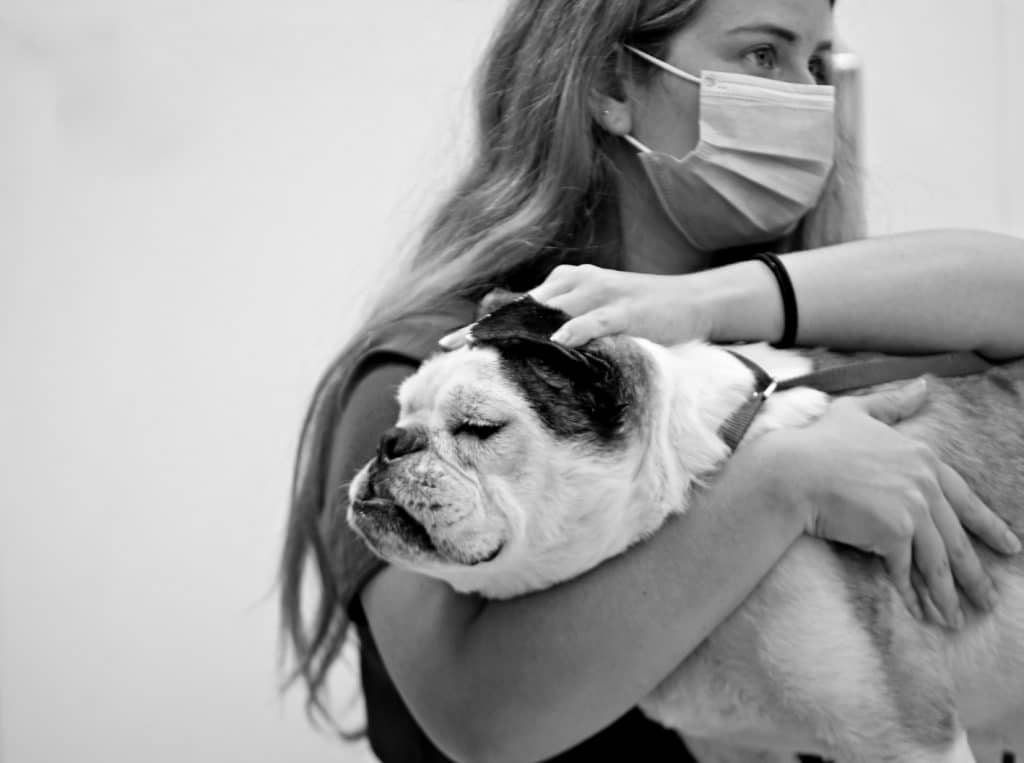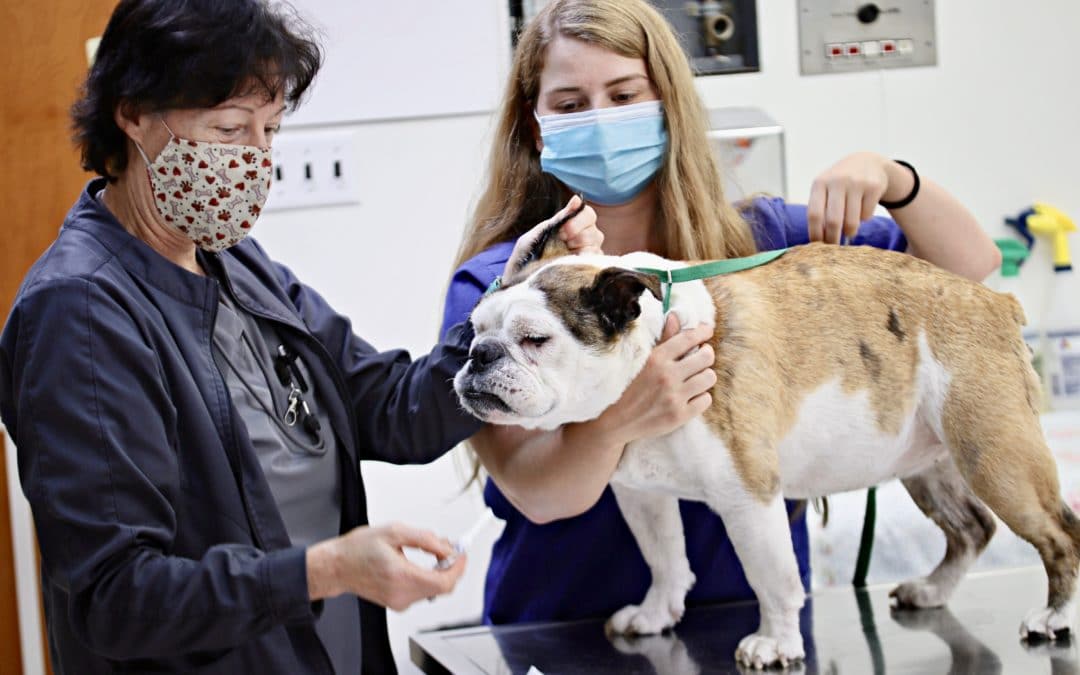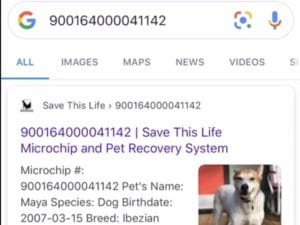What do you do when the unthinkable happens? You look outside, and your dog is no longer out there. You run around the yard looking for them, but you can’t find them anywhere. Panic starts to set in, and after a few minutes, you see your best friend running out from behind the house, and now you can relax again.
But what if he had really run away? At this point, you might be thinking, “how much does it cost to microchip a dog, so I never have to experience this sense of dread again?”
You’re not alone, and may pet owners microchip their dogs and cats to ensure that they’ll always be able to find them in case they get lost. Let’s take a look at the microchip dog cost and some of its benefits.
How Much Does It Cost to Microchip a Dog Near Me?
Table of Contents
- 1 How Much Does It Cost to Microchip a Dog Near Me?
- 2 $45 Save This Life™ Microchip — Google a Lost Pet!!
- 3 Should You Microchip? Researchers Say Yes!
- 4 Microchipping and Its Benefits
- 5 Factors that Affect the Cost of Microchipping a Dog
- 6 What Does the Microchip Implant Look Like?
- 7 Can a Microchip Work as a GPS Tracker?
- 8 How Is a Dog Chip Implanted?
- 9 What’s the Minimum Age to Microchip a Dog?
- 10 Does Microchipping My Dog Hurt Them?
- 11 Is Microchipping a One-Time Expense?
- 12 Can the Microchip Be Removed?
Nationwide, the average cost to microchip a pet at your veterinarian is $45, but it may vary depending on where you live. The microchipping and registration procedure depend on the type of facility you choose and whether you need to register the chip online yourself or if it is done for you by the provider. The cost at AAHA-accredited Paoli Vetcare is $45, including completed registration by our staff, and you can book through our online scheduler right now.
$45 Save This Life™ Microchip — Google a Lost Pet!!
Use a simple Google search to reunite pets with families with a Save This Life™ microchip. Their microchip comes with an aluminum, machine stamped ID tag with “Search this # to Find my Family,” as opposed to a plastic, ink stamped tag or a tag with no microchip number on it, like their competitors.
The number links to a photo of your pet and a secure contact form. You will be sent a text, email, and Google map with your pet’s location.
Standard microchips require the microchip number to be read by a scanner or from an ID tag and then called in to one of many microchip databases, delaying notification of the distressed owner.
Save This Life’s innovative technology has revolutionized the pet recovery process — make an appointment today!
Coverage for up to $1,000 in emergency care for accidents that may occur while your pet is lost is included.
The microchips are ISO compliant, readable by universal scanners, and coated to prevent migration.
There are no registration fees, no annual fees and no fees to update information or transfer pet owners.
You may enjoy watching the one minute video that explains the technology at SaveThisLife.com.
Cost to Microchip a Dog
Each microchip works by registering a specific number for your dog. Your contact information is added to an online registry which links your puppy or kitten’s microchip to you. It’s crucial that you update the microchip registry if you move or change phone numbers. The chip is injected under their skin on the back between the shoulder blades. It will remain dormant until activated when your pet needs to be identified.
Cost to microchip a pet ranges widely from $20 to $75, including registration. There are some scenarios where microchipping your dog is even more affordable—for example, some non-profit humane societies run free microchipping clinics on occasion.
Many pet owners choose to microchip their pets when they are being spayed or neutered. This strategy is a great way to get it taken care of early—while minimizing discomfort to the pet. There are some microchipping clinics out there that, because of the economy of scale, can charge a lower price. If you go to one of these places, you may save a little money, but be sure to add in the cost of registration if it’s not included. Many pet owners simply choose the quality and convenience of their own veterinarian.

Cost of Microchip Registration
In addition to paying for the microchip and the procedure, there is sometimes an additional registration fee. This cost is usually about $20 and covers the lifetime of your dog.
Paoli Vetcare, like many animal hospitals, includes registration cost in the price of the microchip service—ask when you make your appointment. If you register your microchip yourself, make sure you use a large recovery database like HomeAgain because these are the most widely used, if you ever do need to locate a lost pup.
Without proper registration a microchip is useless—just as a social security number would be meaningless unless it correlated back to a name in a government database. An unregistered chip is almost impossible to trace back to the owner.
A common misconception is that just because a shelter microchipped your pet before you adopted, the microchip is automatically registered to you. In fact, your pet’s microchip may still be registered to the shelter—or even registered to a previous owner. Or, it may be unregistered, if the shelter never registered it on your behalf.
If you adopted your pet, you can check if your pet’s microchip is registered by using AAHA’s pet microchip lookup tool. This useful tool tells you if/where a microchip is registered. The AAHA Universal Pet Microchip Lookup Tool is NOT a microchip registry—it is an internet-based application to assist in the identification of those registries on which a particular microchip is registered, or to provide the chip’s manufacturer if unregistered.
The AAHA tool works by searching the databases of participating companies. It will not return pet owner information contained in the registries’ databases, instead it will identify which registries should be contacted when a lost pet is scanned and a microchip number is identified.
Another important thing worth mentioning is you must remember to update the microchip registration database whenever your contact information changes. This factor is easy to overlook when everything is going well, but you want to make sure to have the right phone number and address in case someone finds your pet and tries to look you up.
Should You Microchip? Researchers Say Yes!
An unbelievable one in three pets will get lost at some time in their life. The statistics on missing pets without permanent identification are grim–less than one-quarter of dogs and less than 2% of cats find their way home!
On the other hand, a large study published in the Journal of the American Veterinary Medical Association (JAVMA) found that there is actually a much higher rate of return of microchipped dogs and cats to their families. Microchips bring home hundreds of thousands of pets
- The return-to-owner rate for microchipped dogs was over 52%–a 238% increase!
- The return-to-owner rate for microchipped cats was dramatically higher at over 38%–a more than 2000% better!
Our veterinarians in Paoli can microchip your baby quickly and easily, helping you gain precious peace of mind. The procedure requires no anesthesia and takes a few minutes to complete. It’s no more painful or invasive than an injection, or routine vaccination shot. The microchip injection comes preloaded in a sterile applicator and is injected under the loose skin between the shoulder blades. The process takes only a few seconds.

Microchipping and Its Benefits
Microchipping your dog can have many important benefits, such as ensuring your dog is returned to you and have proper identification for your pet. For many dog owners, their biggest fear is accidentally losing their furry friend. Sadly there are many different ways your dog can escape or become lost, whether it’s escaping your property, running away, becoming lost on a walk, or getting scared and confused and forgetting how to come home.
In rare cases, your dog might become stolen or kidnapped. In even rarer cases a person might find your dog thinking it’s their own lost pet, which can cause an unfortunate and frustrating dispute. This is another reason why microchipping your dog is a good idea, as it provides irrefutable evidence of the dog’s identity and shows where they live.
Pet microchipping is growing in popularity for all these reasons and more. It’s a proper form of pet identification that can reunite you with your lost pet, and it has many benefits. You need to make an informed decision about microchipping as your dog’s owner, but we’ll start with the positives.
Untamperable Identification
Tags and collars can be removed, destroyed, or altered. When an animal is stolen, it’s easy enough for someone to toss away their collar even if that collar has a name and phone number on it. Microchips are inserted beneath the skin and are smaller than a grain of rice. It makes it difficult for anyone to find their exact location or remove it, and the microchip carries important data such as the dog’s identity, the owner’s identity, place of residence, phone number, and more.
Microchips cannot be altered, and a person cannot doctor the ID on their own. The numbers stored on the ID belong to a database that can only be changed digitally after answering security checks, and the microchipped ID is also stored with your local veterinarian and other services.
Microchipping Is Painless
Any good pet owner is wary about a process that might harm their animal. Thankfully, microchipping is a painless procedure that takes mere seconds with no anesthetic. Your veterinarian will implant the chip between the shoulder blades, where your dog won’t feel it and won’t be bothered.
You Don’t Need To Replace The Microchip
Microchip IDs don’t have working parts, and the microchip remains inactive until it is scanned. It’s completely safe and should last the entire lifetime of your pet, with its details updated only on the digital end by you or your vet.
It Safely Stores Your Personal Info
Identity theft can be a huge problem, and it’s an understandable worry for people. Your dog’s microchip is safely stored and all your personal information remains safe on a database only accessed by you. It’s managed and secured by the microchip provider, meaning only authorized parties have access to the microchip and its information—these parties may include your local veterinary office and animal shelters.
Factors that Affect the Cost of Microchipping a Dog
Type of Microchip
There are two different types of reliable microchips:
The HomeAgain Microchip
This is a permanent pet ID that stays intact so that it can easily be scanned by a microchip scanning device. When your pet becomes lost and is taken to a local animal shelter, they will scan the microchip, read the ID code, and return the pet to you. The number in the HomeAgain microchip is used to identify your pet and recover contact information.
Avid Microchip
The AVID is implantable just like the HomeAgain, and is smaller than a grain of rice. It’s activated by a microchip scanner and holds your pet’s unique ID code as well as your personal home information. This number links to the owner’s contact information so that if your pet becomes lost your local vet or animal shelter can return them to you.
Location of the Microchip Clinic
In order to microchip your dog, simply visit your friendly local neighborhood veterinarian. Most vets keep microchips on hand, and microchipping your pet is just a request that can be handled the same day as any other appointment. Local shelters or businesses sometimes hold microchipping events for a variety of pets; just ask your veterinarian if one of these events is coming up.
Veterinarian Fees
While it’s up to your veterinarian, the average price to get your dog microchipped is in the range of $30 to $50. The price ranges depending on who does it, with local microchipping events sometimes charging less or offering free services. The fee can typically be added to your bill after your next veterinarian appointment.
What Does the Microchip Implant Look Like?
The microchip is only about the size of a grain of rice. It is protected by a glass capsule, ensuring that your pet’s body is never negatively affected by the metal components of the chip, and vice versa. This microchip transmits a low radio frequency signal that can be interpreted by special scanners. The message is read as a series of numbers that correspond to a specific registered animal.
The microchip implant is what most would consider the most effective permanent identification. This method is what we’ve been speaking of so far throughout the article. The chip is around the size of a grain of rice, and it’s implanted under your dog’s skin.
It’s the best way to go because you can never lose it, and it will last forever once the procedure is done. The primary reason many people opt for only collar tags is because of the potential pain or discomfort their dog or cat may experience.
We assure you that the pain is minimal. And if you are really squeamish, elect to microchip during another procedure such as teeth cleaning. If you’re considering getting your pup spayed or neutered, think about doing the microchip at the same time to save them another stressful trip to the vet.
Can a Microchip Work as a GPS Tracker?
You cannot locate or “track” your pet with its microchip. Microchips are “passive transponders,” meaning they don’t contain a power source, so they have no way to signal when your pet is lost. In fact, the chip doesn’t do anything at all until a scanner is passed over it. That’s when the microchip uses the energy produced by the scanner to emit a unique code, which then appears on the scanner.
Is it possible to implant a GPS tracker into a dog? The answer is a hard NO – it is not possible to implant a device, which uses GPS technology to track your pet, into your dog at this time. Why? Because of the large size a GPS-enabled tracker would have to be.
To add a power source to the microchip, you would need to add a battery compartment inside the chip (making it a lot larger than the current injectable size), and your pet would need to be “plugged in” to charge, sort of like an electric car! Not very practical!
Pet GPS collar devices are available, but of course, they’re worn on the outside—on a collar and most are too big for cats at this time. They contain a rechargeable battery that usually lasts about a week between charges. GPS trackers work with a mobile app and a cellular plan allowing you to track a lost dog in almost real-time. If your dog is at high risk for escape or is a highly-trained working dog, consider this an essential addition to the permanent identification of a microchip.
How Is a Dog Chip Implanted?
A microchip is very small. It’s a tiny computer chip in a special housing made of glass. All of the material used to construct the microchip is compatible with living tissue and won’t cause infections or any other problems in your pet. Your veterinarian will implant the microchip beneath the skin between your dog’s shoulder blades, using a special syringe. The process is similar to a vaccine shot, and your pet should experience little to no pain. Most dogs barely notice the insertion.
While the needle used for microchipping is larger than that of a routine vaccine, most dogs react the same to both procedures. If you’re concerned about your pet, you can have your dog microchipped during anesthesia, such as when they are being spayed or neutered. You can also request that the pet be microchipped during a routine dental cleaning, which also requires anesthesia.
After it’s implanted, the microchip can be detected immediately with a special handheld device. The device uses radio waves to scan the microchip and displays your unique code. After placement, the microchip is registered with the microchipping company for a one-time fee. This allows your dog to be tracked back to you. Microchips do not contain a GPS, they simply rely on the information present in the registered microchip in order to locate the owner.
What’s the Minimum Age to Microchip a Dog?
While this depends on the size and breed of your puppy, most puppies should be microchipped at around 8 weeks old and before the sale. Some exemptions do apply, such as if the veterinary surgeon thinks the puppy is too small or if it has obvious health reasons that might prevent the microchipping procedure.
Does Microchipping My Dog Hurt Them?
Microchipping is a painless and quick procedure, but it does involve a needle. Your dog might find the process uncomfortable for a few seconds, but most dogs don’t even notice the process. In rare cases, your dog or puppy might have a reaction to the microchip, in which case you should contact your veterinarian as soon as possible.
Is Microchipping a One-Time Expense?
While there is no universal cost, the procedure can range between $10 and $60 depending on the fees demanded by your veterinarian. When you get your puppy or dog from a shelter, the adoption fee typically includes the cost of microchipping. At your veterinarian, the microchipping fee might be included with other exam fees. Either way, microchipping is a one-time cost since the chip never needs to be replaced, removed, or physically updated.
Can the Microchip Be Removed?
Yes, but you cannot remove the microchip yourself. You should always take your dog to a trusted veterinarian to have its chip removed. Removing a microchip can include a real risk of injury, as it’s technically surgery. If someone doesn’t know what they are doing they could actually harm your dog or puppy. It’s best that microchip removal be handled by trained medical professionals.









